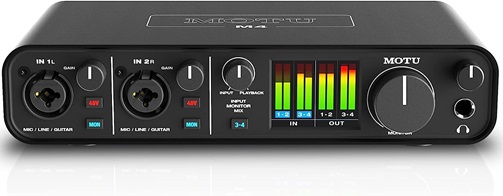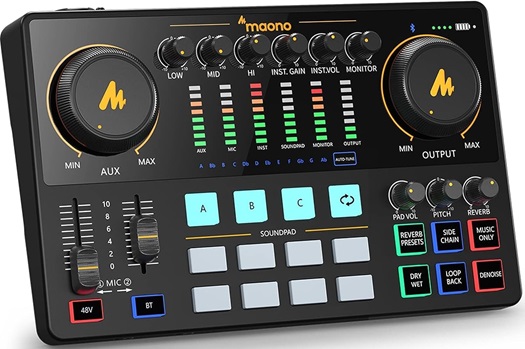When it comes to live performance, an audio interface is an essential part of gear that helps smoothly transfer sound from your instruments and microphones to your computer. To deliver an impeccable performance without any distracting audio glitches, you need an interface that prioritizes low latency and high-quality sound reproduction.
The best audio interfaces for live performance boast three key features:
- Phantom Power: Choose an audio interface with +48V Phantom Power for condenser microphones, ensuring clear and dynamic audio during live performances. This feature is crucial for capturing vocals and instruments with sensitivity.
- Number of Channels: Consider the number of input and output channels you’ll need based on your setup. If you’re a solo artist, a two-channel interface might suffice, while a multi-instrumentalist or band may require an interface with more channels to accommodate multiple inputs simultaneously.
- Audio Resolution: For the most pristine audio quality, opt for an interface that supports high sample rates and bit depths, such as 24-bit/96kHz or higher. This ensures that your recorded and playback audio captures the full dynamic range and detail of your performance.
To learn more about these audio interfaces, check out our comprehensive “Buying Guide.” We’ve also curated a list of the Top Audio Interfaces for Live Performance. Keep reading to find the perfect option for your needs.
Outline
ToggleBest Audio Interfaces For Live Performance Table
| Best Audio interfaces for live performance | Phantom Power | No. of Channels | Audio Resolution | Buy Now |
|---|---|---|---|---|
| Behringer Audio Interface | +48 | 4 | 24-bit/192kHz | Check On Amazon |
| MOTU Audio Interface | 48V | 4 | 48 kHz | Check On Amazon |
| MAONO Audio Interface | 48V | 10 | -- | Check On Amazon |
| Tascam Audio Interface | +48V | 16 | -- | Check On Amazon |
| PreSonus Audio Interface | +48V | 8 | 192 kHz | Check On Amazon |
Best Audio Interfaces For Live Performance Reviews
1. Behringer Audio Interface

The UMC404HD is made to be versatile. It has slots for adding cool effects like compressors, making it easy to mix in different sounds and get creative with your music. This tool gives you good sound quality. It is perfect for both big studios and when you’re on the go. It looks cool and does not take up much space, making any recording place feel better. This device works with popular recording software like Avid Pro Tools, Ableton Live, Steinberg Cubase, and more. The UMC404HD is a reliable and versatile tool. It has MIDI connections and a power supply with +48V.
Best Features:
- Studio-quality 24-bit/192kHz resolution.
- USB 2.0 interface for microphones and instruments.
- Four Midas-designed mic preamps with +48V phantom power.
- Easily integrate external effects like compressors.
- Works seamlessly with popular recording software.
- Exceptional audio fidelity.
Pros:
- Compact and sleek design.
- Versatile for both studio and mobile setups.
- Easy integration with external effects.
- Wide compatibility with popular recording software.
Cons:
- Some users have reported durability issues over time.
2. MOTU Audio Interface

The MOTU M4 has a colorful screen that helps you see and control things easily. It is perfect for live streaming and podcasting. It has special channels that make it easy to use giving you more options when creating your content. It comes with special software called Performer Lite or Live Lite.
Best Features:
- Exceptional audio quality with a dynamic range of 120 dB.
- Ultra-low latency (2.5 ms) for a seamless creative process.
- Full-color LCD for precise metering and easy control.
- 48KHz of Audio Resolution
- Loopback channels for effortless live streaming and podcasting.
- Bundled with Performer Lite or Live Lite software and a vast library of loops and sounds.
Pros:
- High-quality sound reproduction.
- Fast and responsive performance.
- Intuitive interface with visual metering.
- Versatile for live streaming and podcasting.
- Comprehensive software and content package.
Cons:
- Loose USB connection
3. MAONO Audio Interface

The special thing about the MAONO Audio Interface is that it has 11 customizable sound pads. This lets you improve your podcast by adding different sounds and creating an interesting audio experience. This mixer is perfect for making your voice or instruments sound even better. It has a 6.35mm jack making it easy to connect guitars, basses, and other instruments. It is versatile because it works with different types of microphones, like XLR condenser/dynamic ones, 6.35mm dynamic ones, and 3.5mm ones.
Best Features:
- Compatible with various microphones and instruments.
- 10-channel podcast mixer
- 11 sound pads for creative podcast enhancements.
- Built-in preamp with phantom power for XLR mics.
- 3-level adjustment, up to 60dB for dynamic microphones.
Pros:
- Elevates voice and instrument quality.
- Sound pads for dynamic and engaging content.
Cons:
- Buzzing noise in the headphones
- Mixer does not allow you to control the volume of the inputs and outputs.
4. Tascam Audio Interface

This tool has eight balanced outputs for your audio projects, giving you a complete way to keep track of your sound. The included mixer makes sure your digital mixing is smooth and fast perfect for both the studio and live performances. This tool makes your recordings sound amazing and gives you lots of options. It has good preamps and is easy to use changing how you record and make music.
Best Features:
- Allows versatile recording options.
- Ensures exceptional audio quality.
- Eight additional line inputs, with two switchable for instruments.
- Eight outputs for comprehensive monitoring.
- Easy-to-use DSP mixer.
- Suitable for both studio and stage use.
- Enables low-latency digital mixing.
Pros:
- High-quality audio performance.
- Versatility for various instruments.
- Comprehensive monitoring capabilities.
Cons:
- May be relatively expensive.
- Plenty of popping noises
5. PreSonus Audio Interface

It helps with simple planning, and control-room connections, and gives you lots of creative options. It is a powerful tool that is made with high-quality digital parts, precise timing, and a strong build. It is used for mixing, mastering, and podcasting.
Best Features:
- 18×8 I/O Configuration (8×8 at 192 kHz)
- 2 XMAX Class A Mic Preamps
- Versatile Connectivity (ADAT Optical, TRS Line Inputs, MIDI, S/PDIF)
- Zero-Latency Monitor Mixing with an 18×6 DSP Mixer
- Robust construction for durability.
- Ideal for mixing, mastering, podcasting, live performances, and project studios.
- Studio One Artist Software and UC Surface Compatibility
Pros:
- Exceptional sound quality with high-grade converters and low-jitter clocking.
- Flexible inputs for various instruments and recording scenarios.
Cons:
- Requires external power, limiting portability.
Buying Guide For The Audio Interfaces For Live Performance
1. Phantom Power
Phantom power is a power supply that can be provided to microphones through an audio interface. It’s necessary for condenser microphones to operate. If you’re planning to use condenser microphones, make sure that the interface you choose has phantom power.
2. No. of Channels
The number of channels you need depends on how many instruments and microphones you plan to record or perform with. If you’re a solo artist, a two-channel interface may be all you need. But if you’re in a band, or if you want to record multiple instruments at the same time, you’ll need an interface with more channels.
3. Audio Resolution
Audio resolution is the amount of detail that an audio interface can capture. It’s measured in bits per sample (bit depth) and sample rate. The higher the bit depth and sample rate, the better the sound quality. For live performance, you should choose an interface that supports at least 16-bit audio at a 44.1 kHz sample rate. However, if you’re serious about recording and mixing, you may want to choose an interface that supports higher resolutions, such as 24-bit/96 kHz or even 32-bit/192 kHz.
4. Connectivity Technology
The most common connectivity technologies for audio interfaces are USB and Thunderbolt. USB interfaces are more affordable and widely compatible, but Thunderbolt interfaces offer faster data transfer speeds and lower latency. If you’re using a lot of inputs and outputs, or if you need to record high-resolution audio, a Thunderbolt interface is the best option.
5. Dynamic Range
Dynamic range is the difference between the loudest and softest sounds that an audio interface can record or reproduce. It’s measured in decibels (dB). The higher the dynamic range, the more accurately the interface can capture and reproduce the full range of human hearing. For live performance, you should choose an interface with a dynamic range of at least 100 dB.
6. Gain Rate
The gain rate is the amount of amplification that an audio interface can provide. It’s measured in decibels per volt (dBV). The higher the gain rate, the more powerful the interface’s preamps are. For live performance, you’ll need an interface with preamps that have enough gain to boost the signal from your instruments and microphones to a level that can be recorded or reproduced accurately.
7. Compatibility
When choosing an audio interface, it’s important to make sure that it’s compatible with your computer and your other audio gear. Check to make sure that the interface has the right connectors for your instruments and microphones, and that it’s compatible with your computer’s operating system.
8. Latency Rate
Choose a live-performance audio interface with low latency for instant response. Choose features that minimize delays, ensuring smooth performances. Look for interfaces designed for minimal lag to enhance the real-time experience during live shows.
Audio Interfaces For Live Performance – FAQs
Ans: Certainly, inexpensive audio interfaces can offer superior sound quality compared to the built-in soundcard of your computer. Nevertheless, opting for premium audio interfaces equipped with superior Analog-to-Digital Converters (ADCs) and Digital-to-Analog Converters (DACs) will further enhance the overall audio experience.
Ans: The sound quality is not directly influenced by the price of an interface. However, it is commonly observed that higher-priced interfaces tend to feature superior components, particularly in terms of preamps and converters, though exceptions do exist.
Ans: While an audio interface is not a substitute for a mixer in live sound reinforcement, it serves as a suitable replacement in small recording or streaming setups. This is especially true for scenarios involving a limited number of microphones, a solo instrumentalist, or similar setups. The key is ensuring that the interface meets your specific input and output requirements.
Ans: Determining the best digital mixer for live sound depends on your specific needs and budget. Some popular options include the Behringer and MOTU. Consider factors like channel count, features, and ease of use to find the ideal mixer for your setup.
Ans: Enhanced latency performance is achieved through superior audio drivers, typically recommended by your audio interface manufacturer. Following their guidance ensures optimal results. Efficient coordination between your audio interface and computer, facilitated by a quality audio driver, significantly improves latency performance. ASIO-based drivers are commonly employed in Windows systems.
Conclusion
For live performance, the choice of an audio interface is crucial for ensuring optimal sound quality and reliability. Among the options considered, the Behringer, MOTU, and PreSonus audio interfaces stand out as top recommendations.
- The Behringer Audio Interface offers an excellent balance of affordability and performance. It comes with +48V phantom power for condenser microphones, ensuring clear and dynamic audio recordings. It captures audio resolution of 24-bit/192kHz.
- The MOTU Audio Interface is recognized for its professional-grade quality and advanced capabilities. It is perfect for live streaming and podcasting. It comes with 48KHz of Audio Resolution. It can make sounds clear with a dynamic range of 120 dB.
- PreSonus Audio Interface is praised for its user-friendly design and exceptional sound quality. This interface comes with 18 inputs and 8 outputs, delivering good sound and easy connections at 192 kHz.

